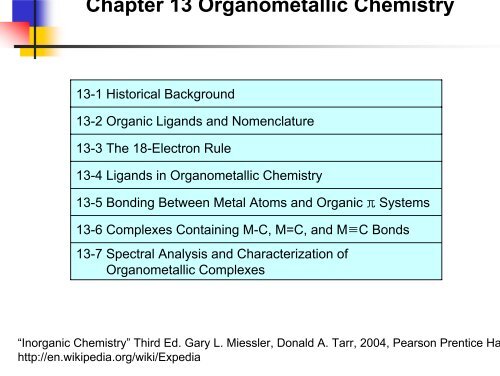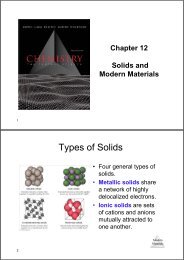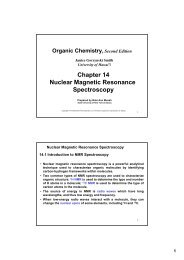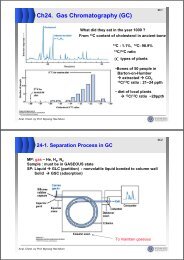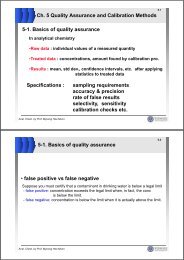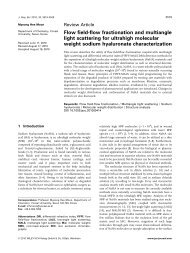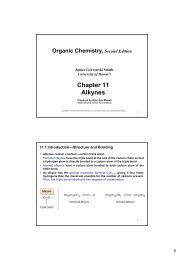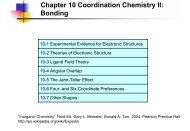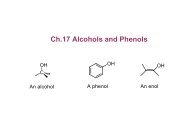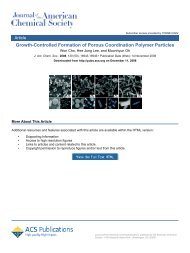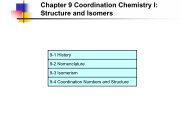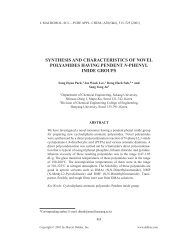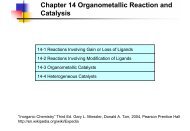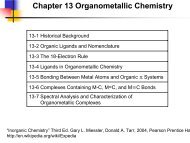13-4 Ligands in Organometallic Chemistry
13-4 Ligands in Organometallic Chemistry
13-4 Ligands in Organometallic Chemistry
Create successful ePaper yourself
Turn your PDF publications into a flip-book with our unique Google optimized e-Paper software.
Chapter <strong>13</strong> <strong>Organometallic</strong> <strong>Chemistry</strong><br />
<strong>13</strong>-1 Historical Background<br />
<strong>13</strong>-2 Organic <strong>Ligands</strong> and Nomenclature<br />
<strong>13</strong>-3 The 18-Electron Rule<br />
<strong>13</strong>-4 <strong>Ligands</strong> <strong>in</strong> <strong>Organometallic</strong> <strong>Chemistry</strong><br />
<strong>13</strong>-5 Bond<strong>in</strong>g Between Metal Atoms and Organic π Systems<br />
<strong>13</strong>-6 Complexes Conta<strong>in</strong><strong>in</strong>g M-C, M=C, and M≡C Bonds<br />
<strong>13</strong>-7 Spectral Analysis and Characterization of<br />
<strong>Organometallic</strong> Complexes<br />
“Inorganic <strong>Chemistry</strong>” Third Ed. Gary L. Miessler, Donald A. Tarr, 2004, Pearson Prentice Ha<br />
http://en.wikipedia.org/wiki/Expedia
<strong>13</strong>-1 Historical Background<br />
Sandwich compounds<br />
Cluster compounds
<strong>13</strong>-1 Historical Background<br />
Other examples of organometallic compounds
<strong>13</strong>-1 Historical Background<br />
<strong>Organometallic</strong> Compound<br />
<strong>Organometallic</strong> chemistry is the study of chemical compounds<br />
conta<strong>in</strong><strong>in</strong>g bonds between carbon and a metal.<br />
<strong>Organometallic</strong> chemistry comb<strong>in</strong>es aspects of <strong>in</strong>organic<br />
chemistry and organic chemistry.<br />
<strong>Organometallic</strong> compounds f<strong>in</strong>d practical use <strong>in</strong> stoichiometric<br />
and catalytically active compounds.<br />
Electron count<strong>in</strong>g is key <strong>in</strong> understand<strong>in</strong>g organometallic<br />
chemistry. The 18-electron rule is helpful <strong>in</strong> predict<strong>in</strong>g the<br />
stabilities of organometallic compounds. <strong>Organometallic</strong><br />
compounds which have 18 electrons (filled s, p, and d orbitals)<br />
are relatively stable. This suggests the compound is isolable, but<br />
it can result <strong>in</strong> the compound be<strong>in</strong>g <strong>in</strong>ert.
<strong>13</strong>-1 Historical Background<br />
In attempt to synthesize fulvalene<br />
Produced an orange solid (ferrocene)<br />
Discovery of ferrocene began the era of modern organometallic<br />
chemistry.<br />
Staggered r<strong>in</strong>gs Eclipsed r<strong>in</strong>gs Skew r<strong>in</strong>gs
<strong>13</strong>-2 Organic <strong>Ligands</strong> and Nomenclature<br />
Write hydrocarbon ligands before the metal.<br />
η<br />
superscript<br />
Bridg<strong>in</strong>g ligand - μ<br />
Subscript <strong>in</strong>dicat<strong>in</strong>g the number of metal atoms bridged.
<strong>13</strong>-2 Organic <strong>Ligands</strong> and Nomenclature
<strong>13</strong>-3 The 18-Electron Rule<br />
; count<strong>in</strong>g electrons<br />
In ma<strong>in</strong> group chemistry, the octet rule<br />
Donor Pair method<br />
Neutral Ligand method
<strong>13</strong>-3 The 18-Electron Rule<br />
; count<strong>in</strong>g electrons<br />
M-M s<strong>in</strong>gle bond counts as one electron per metal
<strong>13</strong>-3 The 18-Electron Rule<br />
; why 18 electrons?<br />
s 2 p 6 vs s 2 p 6 d 10<br />
Have to consider<br />
types of ligand<br />
Strong σ–donor<br />
ability of CO<br />
Strong π–acceptor<br />
ability of CO<br />
Good for 18-<br />
electron rule
<strong>13</strong>-3 The 18-Electron Rule<br />
; why 18 electrons?<br />
[Zn(en) 3 ] 2+ ; ?? Electron species<br />
good σ-donor not as strong as CO<br />
e g orbitals are not sufficiently<br />
antibond<strong>in</strong>g<br />
TiF 6<br />
2-<br />
; ?? Electron species<br />
σ-donor<br />
π-donor<br />
What happen?
Ligand field theory;<br />
Pi-Bond<strong>in</strong>g<br />
metal-to-ligand π bond<strong>in</strong>g<br />
or π back-bond<strong>in</strong>g<br />
-Increase stability<br />
-Low-sp<strong>in</strong> configuration<br />
-Result of transfer of<br />
negative charge away from<br />
the metal ion<br />
Ligand-to metal π bond<strong>in</strong>g<br />
-decrease stability<br />
-high-sp<strong>in</strong> configuration
<strong>13</strong>-3 The 18-Electron Rule<br />
; square-planar complexes<br />
16 electron complexes<br />
might be stable<br />
Square-planar<br />
complexes have<br />
important catalytic<br />
behavior<br />
Why?
<strong>13</strong>-4 <strong>Ligands</strong> <strong>in</strong> <strong>Organometallic</strong> <strong>Chemistry</strong><br />
; carbonyl (CO) complexes
<strong>13</strong>-4 <strong>Ligands</strong> <strong>in</strong> <strong>Organometallic</strong> <strong>Chemistry</strong><br />
; carbonyl (CO) complexes
<strong>13</strong>-4 <strong>Ligands</strong> <strong>in</strong> <strong>Organometallic</strong> <strong>Chemistry</strong><br />
; carbonyl (CO) complexes<br />
Experimental evidence<br />
Free CO vs M-CO<br />
Infrared spectroscopy and X-ray crystallography<br />
Free CO has a C-O stretch at 2143 cm -1<br />
Cr(CO) 6 has a C-O stretch at 2000 cm -1<br />
C-O distance 112.8 pm<br />
Metal complexes 115 pm
<strong>13</strong>-4 <strong>Ligands</strong> <strong>in</strong> <strong>Organometallic</strong> <strong>Chemistry</strong><br />
; carbonyl (CO) complexes<br />
In general, the more negative the charge on the<br />
organometallic species, the greater the tendency<br />
of the metal to donate electrons to the π* orbitals<br />
of CO and the lower the energy of the C-O<br />
stretch<strong>in</strong>g vibrations.
<strong>13</strong>-4 <strong>Ligands</strong> <strong>in</strong> <strong>Organometallic</strong> <strong>Chemistry</strong><br />
; bridg<strong>in</strong>g modes of CO
<strong>13</strong>-4 <strong>Ligands</strong> <strong>in</strong> <strong>Organometallic</strong> <strong>Chemistry</strong><br />
; bridg<strong>in</strong>g modes of CO<br />
Term<strong>in</strong>al and bridg<strong>in</strong>g carbonyl ligands can be<br />
considered 2-electron donors.
<strong>13</strong>-4 <strong>Ligands</strong> <strong>in</strong> <strong>Organometallic</strong> <strong>Chemistry</strong><br />
; bridg<strong>in</strong>g modes of CO
<strong>13</strong>-4 <strong>Ligands</strong> <strong>in</strong> <strong>Organometallic</strong> <strong>Chemistry</strong><br />
; b<strong>in</strong>ary carbonyl complexes<br />
17-e - too small to permit a<br />
seventh coord<strong>in</strong>ation site<br />
B<strong>in</strong>ary carbonyl complexes<br />
More detail<br />
analysis is<br />
necessary
<strong>13</strong>-4 <strong>Ligands</strong> <strong>in</strong> <strong>Organometallic</strong> <strong>Chemistry</strong><br />
; b<strong>in</strong>ary carbonyl complexes<br />
Synthesis of b<strong>in</strong>ary carbonyl complexes<br />
1. Direct reaction of a transition metal and CO; high T & P<br />
2. Reductive carbonylations<br />
3. Thermal or photochemical reaction<br />
Exchange reaction
<strong>13</strong>-4 <strong>Ligands</strong> <strong>in</strong> <strong>Organometallic</strong> <strong>Chemistry</strong><br />
; oxygen-bonded cabonyls
<strong>13</strong>-4 <strong>Ligands</strong> <strong>in</strong> <strong>Organometallic</strong> <strong>Chemistry</strong><br />
; ligands similar to CO<br />
CS, CSe<br />
Similar to CO <strong>in</strong> their bond<strong>in</strong>g modes<br />
In term<strong>in</strong>al or bridg<strong>in</strong>g<br />
CS usually functions as a stronger σ donor and π acceptor<br />
than CO<br />
isoelectronic; CN - and N 2<br />
CN - is a stronger σ donor and a somewhat π weaker<br />
acceptor than CO<br />
CN - bonds readily to metals hav<strong>in</strong>g higher oxidation states<br />
N 2 is a weaker donor and acceptor than CO<br />
Nitrogen fixation
<strong>13</strong>-4 <strong>Ligands</strong> <strong>in</strong> <strong>Organometallic</strong> <strong>Chemistry</strong><br />
; ligands similar to CO; NO complexes
<strong>13</strong>-4 <strong>Ligands</strong> <strong>in</strong> <strong>Organometallic</strong> <strong>Chemistry</strong><br />
; hydride and dihydrogen complexes<br />
Organic synthesis,<br />
catalytic reaction<br />
Hydride complexes
<strong>13</strong>-4 <strong>Ligands</strong> <strong>in</strong> <strong>Organometallic</strong> <strong>Chemistry</strong><br />
; hydride and dihydrogen complexes<br />
Organic synthesis,<br />
catalytic reaction<br />
Dihydrogen complexes<br />
Distance of H-H<br />
the metal is electron rich and donate<br />
strongly to the π* of H 2 → ???<br />
with CO and NO → ???
<strong>13</strong>-4 <strong>Ligands</strong> <strong>in</strong> <strong>Organometallic</strong> <strong>Chemistry</strong><br />
; ligands hav<strong>in</strong>g extended π systems<br />
π bond<strong>in</strong>g with<strong>in</strong> the ligands themselvesl<strong>in</strong>ear<br />
systems
<strong>13</strong>-4 <strong>Ligands</strong> <strong>in</strong> <strong>Organometallic</strong> <strong>Chemistry</strong><br />
; ligands hav<strong>in</strong>g extended π systems<br />
π bond<strong>in</strong>g with<strong>in</strong> the ligands themselvesl<strong>in</strong>ear<br />
systems
<strong>13</strong>-4 <strong>Ligands</strong> <strong>in</strong> <strong>Organometallic</strong> <strong>Chemistry</strong><br />
; ligands hav<strong>in</strong>g extended π systems<br />
π bond<strong>in</strong>g with<strong>in</strong> the ligands themselvescyclic<br />
systems
<strong>13</strong>-4 <strong>Ligands</strong> <strong>in</strong> <strong>Organometallic</strong> <strong>Chemistry</strong><br />
; ligands hav<strong>in</strong>g extended π systems<br />
π bond<strong>in</strong>g with<strong>in</strong> the ligands themselvescyclic<br />
systems
<strong>13</strong>-4 Bond<strong>in</strong>g between Metal Atoms and Organic π<br />
Systems; l<strong>in</strong>ear π systems<br />
π –ethylene complexes<br />
Typically bent back<br />
away from the metal<br />
π-bond<strong>in</strong>g electron pair<br />
the empty π*-orbital<br />
Free ethylene <strong>13</strong>3.7 pm, 1623 cm -1<br />
Coord<strong>in</strong>ated ethylene <strong>13</strong>7.5 pm, 1516 cm -1
<strong>13</strong>-4 Bond<strong>in</strong>g between Metal Atoms and Organic π<br />
Systems; l<strong>in</strong>ear π systems<br />
π –allyl complexes<br />
acceptor<br />
Donor or acceptor<br />
donor
<strong>13</strong>-4 Bond<strong>in</strong>g between Metal Atoms and Organic π<br />
Systems; l<strong>in</strong>ear π systems<br />
π –allyl complexes<br />
Conversion between η 1 and η 3<br />
Catalytic reaction<br />
Other l<strong>in</strong>ear π systems
<strong>13</strong>-4 Bond<strong>in</strong>g between Metal Atoms and Organic π<br />
Systems; cyclic π systems<br />
Cyclopentadienyl (Cp) complexes<br />
η 1 , η 3 and η 5<br />
C 5 (CH 3 ) 5 Cp*<br />
Gas phase and low-T<br />
Most stable conformation
<strong>13</strong>-4 Bond<strong>in</strong>g between Metal Atoms and Organic π<br />
Systems; cyclic π systems
olecular orbital<br />
nergy levels of<br />
errocene<br />
<strong>13</strong>-4 Bond<strong>in</strong>g between Metal Atoms and Organic π<br />
Systems; cyclic π systems
<strong>13</strong>-4 Bond<strong>in</strong>g between Metal Atoms and Organic π<br />
Systems; cyclic π systems
<strong>13</strong>-4 Bond<strong>in</strong>g between Metal Atoms and Organic π<br />
Systems; cyclic π systems<br />
Other metallocenes<br />
# of electron → stability → reactivity
<strong>13</strong>-4 Bond<strong>in</strong>g between Metal Atoms and Organic π<br />
Systems; cyclic π systems
<strong>13</strong>-4 Bond<strong>in</strong>g between Metal Atoms and Organic π<br />
Systems; cyclic π systems<br />
Complexes<br />
conta<strong>in</strong><strong>in</strong>g<br />
cyclopentadienyl and<br />
CO ligand<br />
Half-sandwich
<strong>13</strong>-5 Fullerene Complexes<br />
Types of fullerene complexes<br />
1. Adducts to the oxygens<br />
2. As a lignd<br />
3. Encapsulated metals<br />
4. Intercalation compounds of alkali metals<br />
Adducts to the oxygens
<strong>13</strong>-5 Fullerene Complexes<br />
As ligands<br />
Dihapto, pentahepto, hexahapto<br />
Displacement reaction<br />
More than one metal
<strong>13</strong>-5 Fullerene Complexes<br />
C 70<br />
η 2 -η 2 -η 2 and η 5
<strong>13</strong>-5 Fullerene Complexes<br />
Encapsulated metals<br />
By laser-<strong>in</strong>duced vapor phase reactions between carbon and the metal<br />
La@C 82 ; La 3+ , C 82<br />
3-
<strong>13</strong>-6 Complexes Conta<strong>in</strong><strong>in</strong>g M-C, M=C and M≡C Bond
<strong>13</strong>-6 Complexes Conta<strong>in</strong><strong>in</strong>g M-C, M=C and M≡C Bond<br />
; alkyl and related complexes<br />
Synthetic route<br />
Relatively rare: k<strong>in</strong>etically unstable and difficult to isolate<br />
Enhanc<strong>in</strong>g the stability; By block<strong>in</strong>g pathways to decomposition<br />
mtallacycle<br />
Proposed as <strong>in</strong>termediates <strong>in</strong> a variety catalytic processes
<strong>13</strong>-6 Complexes Conta<strong>in</strong><strong>in</strong>g M-C, M=C and M≡C Bond<br />
; alkyl and related complexes
<strong>13</strong>-6 Complexes Conta<strong>in</strong><strong>in</strong>g M-C, M=C and M≡C Bond<br />
; carbene complexes<br />
d orbital<br />
p orbital
<strong>13</strong>-6 Complexes Conta<strong>in</strong><strong>in</strong>g M-C, M=C and M≡C Bond<br />
; carbene complexes<br />
2-electron donor<br />
Highly electronegative atom can participate <strong>in</strong> the π bond<strong>in</strong>g → stabilize
<strong>13</strong>-6 Complexes Conta<strong>in</strong><strong>in</strong>g M-C, M=C and M≡C Bond<br />
; carbene complexes<br />
Olef<strong>in</strong> metathesis<br />
Highly nucleophilic reagent<br />
X-ray; Cr-C, C-O<br />
NMR; RT (one signal), low T (two peak)<br />
Why?<br />
C-O 143 pm<br />
C=O 116pm<br />
Highly electronegative atom can participate <strong>in</strong> the π bond<strong>in</strong>g → stabilize
<strong>13</strong>-6 Complexes Conta<strong>in</strong><strong>in</strong>g M-C, M=C and M≡C Bond<br />
; carbyne (alkylidyne) complexes<br />
3-electron donor<br />
Lewis acid<br />
σ donor<br />
π acceptor
<strong>13</strong>-6 Spectral Analysis and Characterization of<br />
<strong>Organometallic</strong> Complexes; IR spectra<br />
X-ray, Mass spectrometry, elemental<br />
analysis, conductivity measurement etc<br />
# of bands<br />
Provide clues to the geometry or symmetry
<strong>13</strong>-6 Spectral Analysis and Characterization of<br />
<strong>Organometallic</strong> Complexes; IR spectra
<strong>13</strong>-6 Spectral Analysis and Characterization of<br />
<strong>Organometallic</strong> Complexes; IR spectra<br />
positions of bands<br />
Provide clues to the electronic environment on the metal<br />
The greater the electronic density on the metal → ???<br />
In general, the more negative the charge on the<br />
organometallic species, the greater the tendency<br />
of the metal to donate electrons to the π* orbitals<br />
of CO and the lower the energy of the C-O<br />
stretch<strong>in</strong>g vibrations.
<strong>13</strong>-6 Spectral Analysis and Characterization of<br />
<strong>Organometallic</strong> Complexes; IR spectra<br />
What do you get from this data?<br />
Other ligands also have similar correlation. (NO…)
<strong>13</strong>-6 Spectral Analysis and Characterization of<br />
<strong>Organometallic</strong> Complexes; NMR spectra<br />
1<br />
H, <strong>13</strong> C, 19 F, 31 P, metal nuclei etc.<br />
Chemical shifts, splitt<strong>in</strong>g patterns, coupl<strong>in</strong>g constants<br />
<strong>13</strong><br />
C NMR<br />
Chemical shift
<strong>13</strong>-6 Spectral Analysis and Characterization of<br />
<strong>Organometallic</strong> Complexes; NMR spectra<br />
1<br />
H NMR<br />
<strong>in</strong>tegration
<strong>13</strong>-6 Spectral Analysis and Characterization of<br />
<strong>Organometallic</strong> Complexes; NMR spectra<br />
Molecular rearrangement processes<br />
At RT; 2 s<strong>in</strong>glets<br />
At low T<br />
R<strong>in</strong>g whizzer


